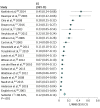Evaluation of the Number-Needed-to-Biopsy Metric for the Diagnosis of Cutaneous Melanoma: A Systematic Review and Meta-analysis
- PMID: 31290958
- PMCID: PMC6624799
- DOI: 10.1001/jamadermatol.2019.1514
Evaluation of the Number-Needed-to-Biopsy Metric for the Diagnosis of Cutaneous Melanoma: A Systematic Review and Meta-analysis
Abstract
Importance: To date, no concerted effort has been made to date to evaluate the literature on number-needed-to-biopsy (NNB) metrics, particularly to account for the differences in clinician type and melanoma prevalence in certain geographic locations.
Objective: To review and synthesize worldwide data for NNB for the diagnosis of cutaneous melanoma.
Data source: MEDLINE, Embase, and PubMed databases were searched for English-language articles published worldwide from January 1, 2000, to November 28, 2018.
Study selection: A total of 46 studies were included that addressed NNB for at least 3681 clinicians worldwide and included 455 496 biopsied tumors and 29 257 melanomas; primary care practitioner (PCP) data were only available from Australia.
Data extraction and synthesis: Articles were screened for eligibility, and possible overlapping data sets were resolved. Data extracted included clinician specialization, use of dermoscopy, geographic region and location-specific health care system, study design, number of benign tumors, number of melanomas, and NNB. The review followed the PRISMA guidelines.
Main outcome and measures: The NNB for the diagnosis of cutaneous melanoma.
Results: A total of 46 studies were included that addressed NNB for at least 3681 clinicians worldwide and included 455 496 biopsied tumors and 29 257 melanomas; primary care practitioner (PCP) data were only available from Australia. The reported NNB ranged from 2.2 to 287, and the weighted mean NNB for all included publications was 15.6. The exclusion of publications structured as all biopsied tumors, owing to variable data characterization, resulted in reported NNB ranging from 2.2 to 30.5, with a global weighted mean NNB of 14.8 for all clinicians, 7.5 for all dermatologists, 14.6 for Australian PCPs, and 13.2 for all US-based dermatological practitioners, including dermatologists and advanced practice professionals. The summary effect size (ES) demonstrates that a mean 4% of biopsies demonstrated melanoma for study stratum A (all biopsied skin tumors, ES, 0.04; 95% CI, 0.03-0.05), and a mean 12% of biopsies demonstrated melanoma for study strata B (melanocytic tumors on pathology review, ES, 0.12; 95% CI, 0.10-0.14) and C (clinical concern for melanoma, ES; 0.12; 95% CI, 0.09-0.14).
Conclusions and relevance: The existing NNB for cutaneous melanoma appeared to vary widely worldwide, lacking standardization in the metric and its reporting, and according to clinician characteristics as well; the NNB of US-based clinicians may warrant further exploration.
Conflict of interest statement
Figures


References
-
- Wilkinson D, Askew DA, Dixon A. Skin cancer clinics in Australia: workload profile and performance indicators from an analysis of billing data. Med J Aust. 2006;184(4):162-164. - PubMed
-
- Har-Shai Y, Hai N, Taran A, et al. . Sensitivity and positive predictive values of presurgical clinical diagnosis of excised benign and malignant skin tumors: a prospective study of 835 lesions in 778 patients. Plast Reconstr Surg. 2001;108(7):1982-1989. doi:10.1097/00006534-200112000-00022 - DOI - PubMed

